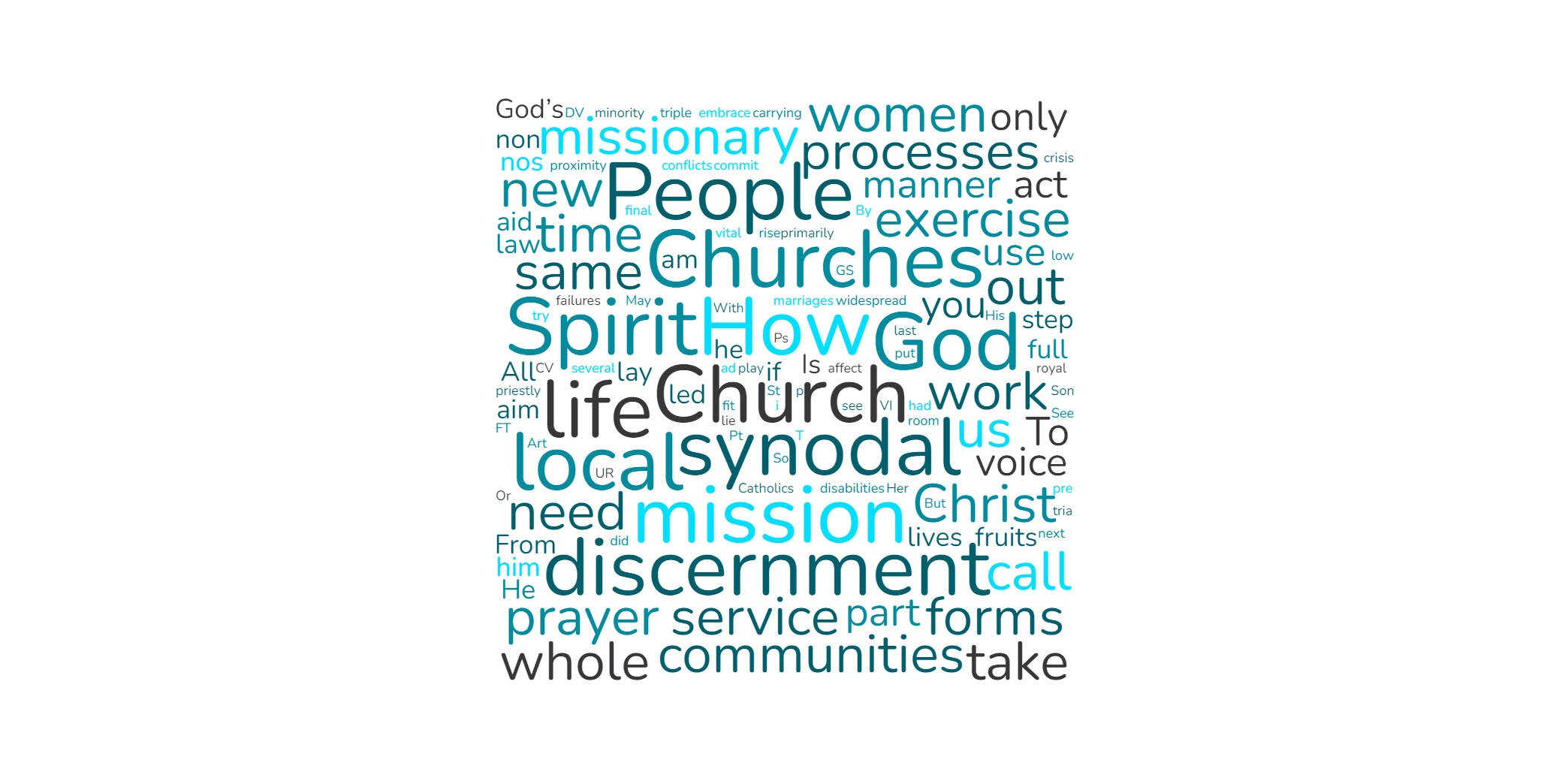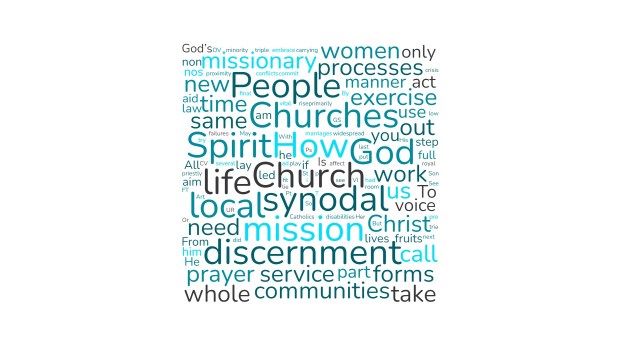On June 20, 2023, the Synod of Bishops published a working document to guide the first session of the Synod on the future of the Church, scheduled for October 2023. This “Instrumentum Laboris” (“instrument of work” in Latin), is intended to help the synodal assembly’s 370 members in their reflection.
“Church,” “Synod” and “how” are some of the words that come up most often in the document. Aleteia explains the synod through the most recurring words in the text.

Church, Ecclesial:484 repetitions
“The aim of this synodal process is to help the Church get to know herself better,” said Cardinal Mario Grech, General Secretary of the Synod of Bishops, at the presentation of the working document. In this synod “on the future of the Church,” the Church is both subject and object, as it is made up of the “people of God” united by the same baptism and capable of walking together. The same applies to the working document, which is “not a document of the Holy See, but of the Church as a whole,” emphasized the Maltese cardinal.
Synod, synodal, synodality:342
Synodality is difficult to define but it is a way of functioning or of living of the Church. Synodality, “walking together,” is a reality inspired by the early days of Christianity and revived by Pope Paul VI after the Second Vatican Council. The Synod refers to an institution, the Synod of Bishops, which is an assembly set up by the Pope at the level of the universal Church to study a specific subject and submit proposals to him. Synods can also take place at the national or diocesan level. The novelty of this “Synod on Synodality” lies in Francis’ challenge to force the Church to question its own functioning and structures.
How:196
One of the distinctive features of this document is the large number of questions it invites the Church to ask itself, in order to find solutions and reflect on a number of issues. The 50-page document is dotted by 274 question that touch various themes evoked by Catholics across the world. Another important aspect of the working document is its methodological dimension, which sets out to explain “how” to discern and act in order to achieve greater synodality.
Mission, missionary:142
“Mission” is one of the three key concepts accompanying the reflection on becoming a synodal Church. In the working document, the term mission was purposefully placed at the center of the other two concepts, which are communion (48 repetitions) and participation (50 repetitions).
According to Cardinal Jean-Claude Hollerich, the relator general of the Synod, this is because the missionary reality of the Church is “an important aspect present as much in communion and participation” and therefore is supposed to link these two dimensions. The Church needs to pursue its mission more effectively, and therefore to be more “missionary,” meaning more open to the world in order to proclaim the Good News.
God, Lord:124
The Church moves forward in this Synod as the People of God, a community that bases its approach on the divine filiation of each of its members through baptism. The Spirit of God is at work here, and must be invoked by all participants. The term “God” is used more often than the name “Jesus,” which appears 14 times, and “Christ,” which is used 35 times.
Assembly: 114
The frequency of the word Assembly attests to the functioning of the entire synodal process. This working document is supposed to guide the reflections of those who will participate in the Synodal Assembly in October 2023 in Rome. This meeting marks the “universal phase” of the synodal process, which has been preceded by a diocesan and continental phase. After the local phase, nations got together by regions in Continental Assemblies that then reported back to Rome.
The document clearly states that the universal October Assembly “cannot be understood as representative and legislative, analogous to a parliamentary structure with its dynamics of majority building.” Rather it is where “Christ becomes present and acts” and “gives the Spirit to guide the Church to find a consensus on how to walk together towards the Kingdom and to help all of humanity to move towards greater unity.”
Spirit, spirituality, spiritual:111
As Pope Francis regularly repeats, the Holy Spirit is the “protagonist” of every synodal process. This is especially true for this Synod, which is questioning its own synodal functioning, in a process that is first and foremost spiritual before being structural. To this end, the working document outlines a prayer-dialogue method, the “Conversation in the Spirit,” to teach the People of God to turn more confidently to the third person of the Trinity. The word “holy” appears 22 times.
Life, live: 110
Synodality is a “modus vivendi et operandi” meaning a method but also a way of living of the Church. It not only affects each faithful’s individual life, as synodality calls us to reflect on our relations with others, with the world around us and with the Church itself, but it also affects how the Church lives and functions as a whole.
People: 110
“The synodal process offers an opportunity for an encounter in faith that makes the bond with the Lord, fraternity between people and love for the Church,” the working document states. The local and continental phases have given the Church the opportunity to listen “to the People of God” and have them share their real and concrete experiences. Now the synodal process will continue to encourage Catholics to continue on this path of “walking together” as one People of God. “This Church is not afraid of the variety it bears, but values without forcing it into uniformity,” the text explains.
Discernment, discern: 106
Firmly rooted in Jesuit spirituality, the current Synod encourages the Church and each of its members to discern and creatively evaluate possible solutions to the challenges it faces. To bring this experience to life, the working document invites each reader to confront a number of “question[s] for discernment,” which are brought together in the second part of the document. Pope Francis has done several catecheses on the topics of discernment during his general audiences.
Other terms
Some other terms that came up often in the English version of the working document are : “community” (96 repetitions), “other” or “another” (95), process (87), local (73) and together (70).

